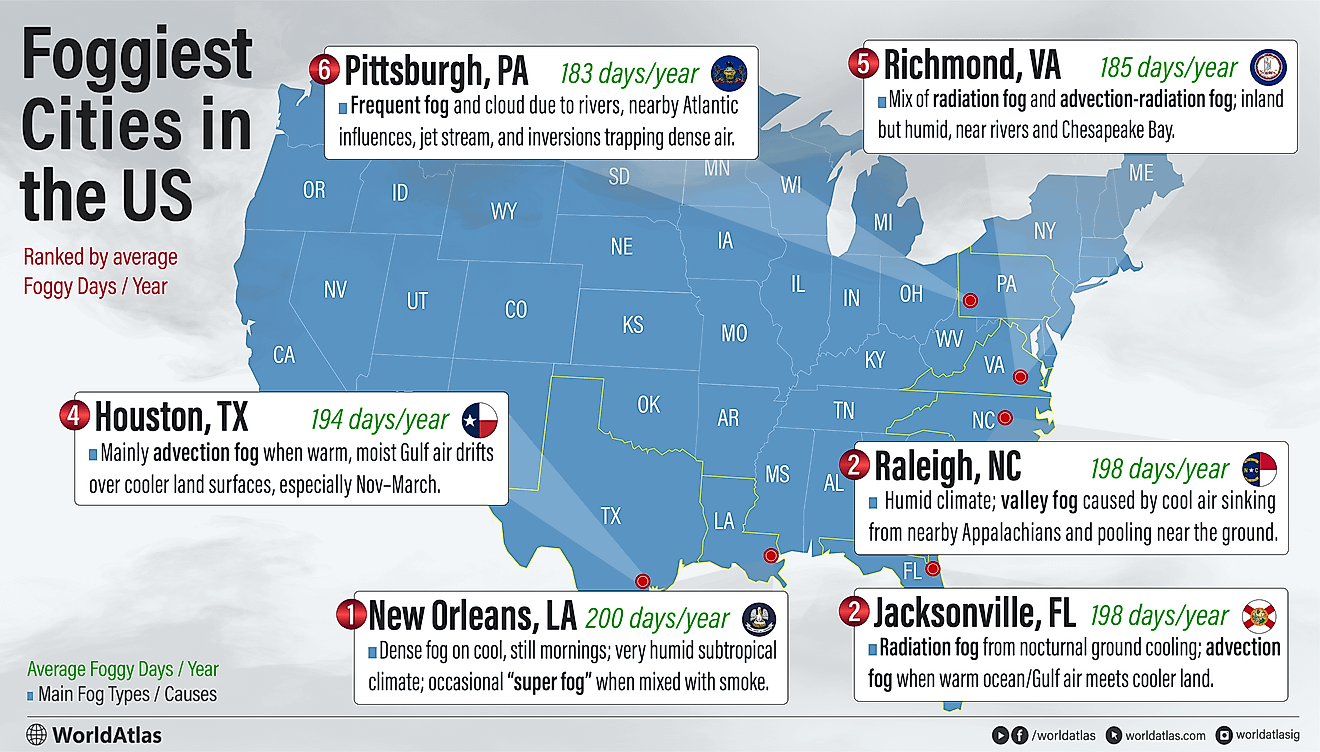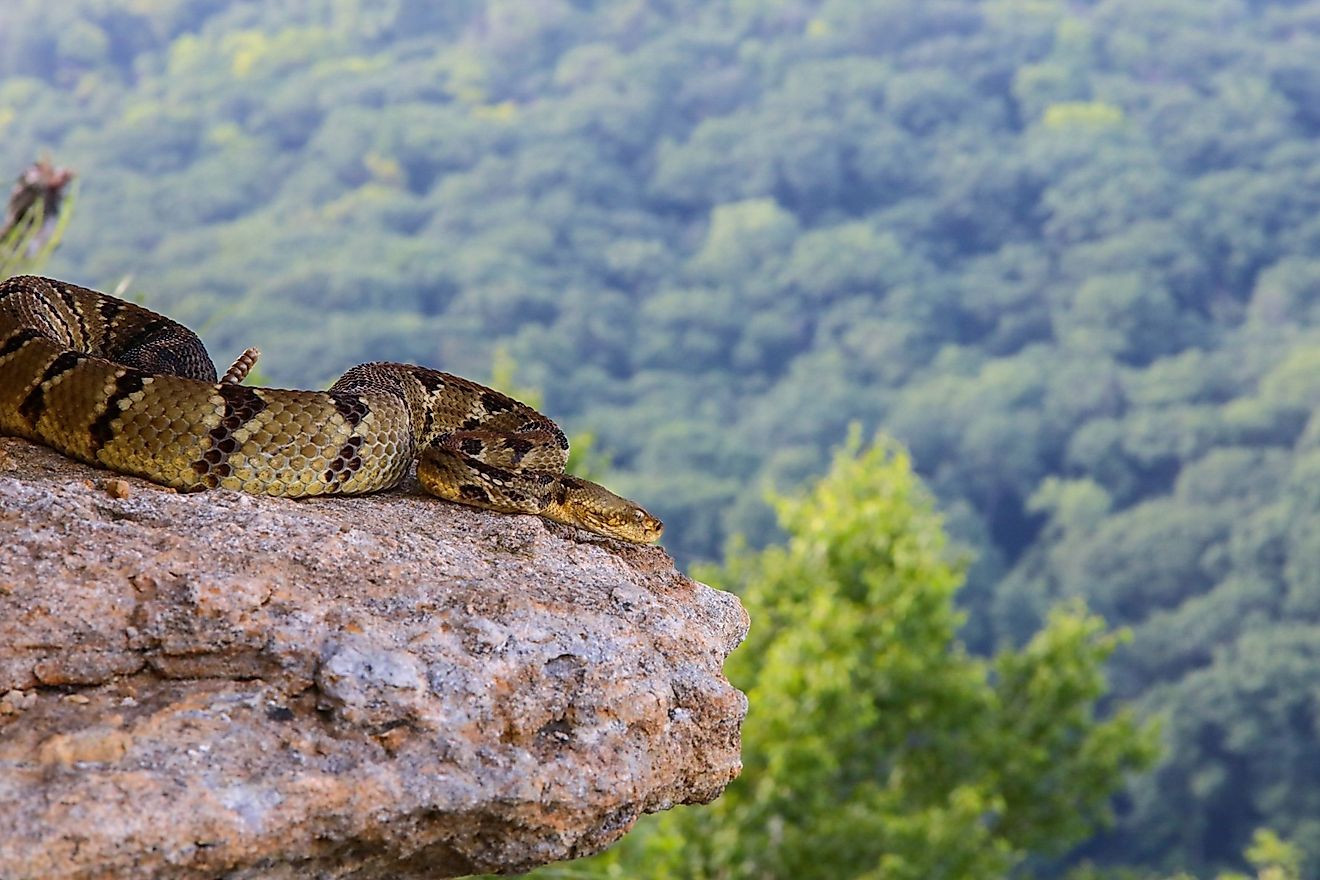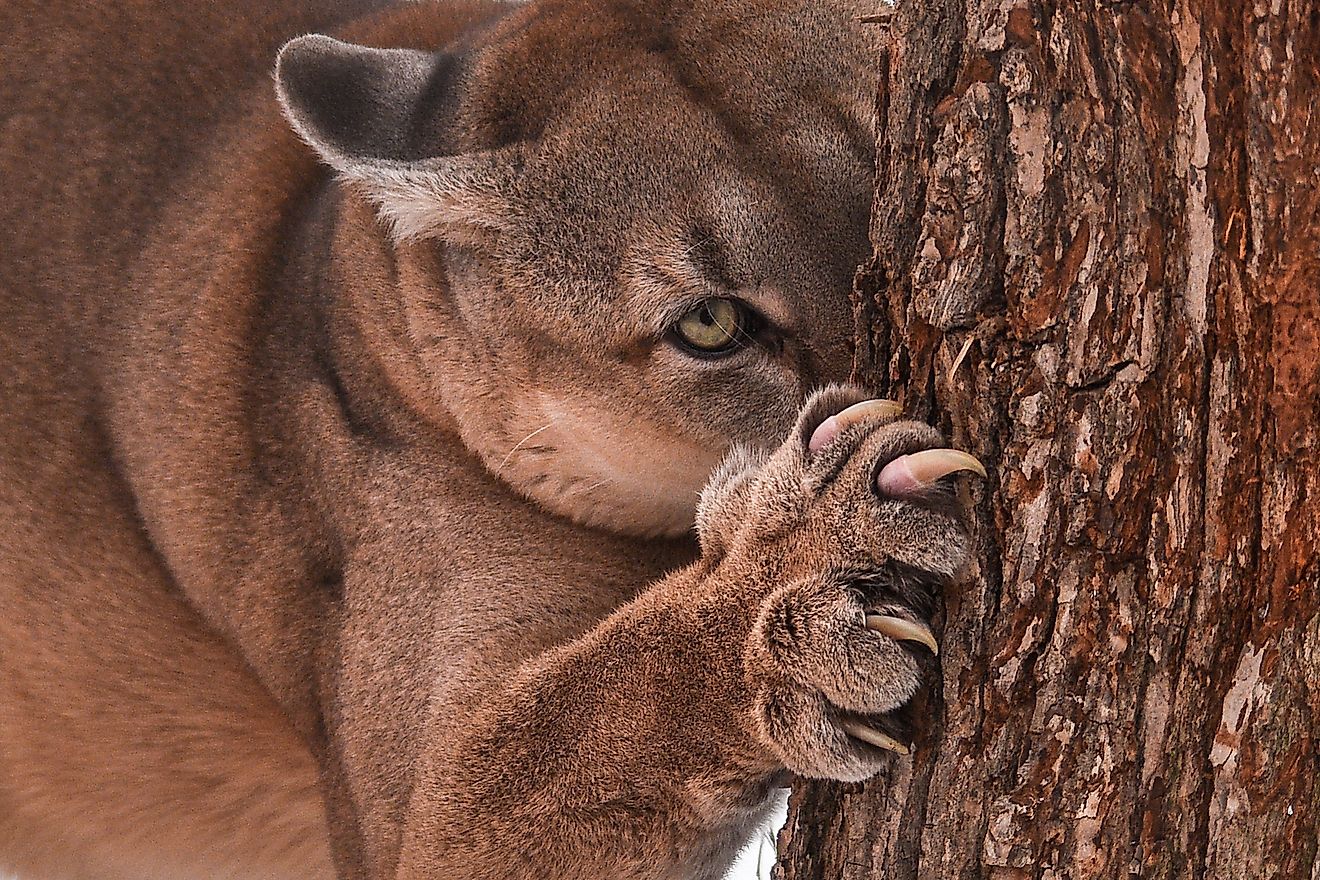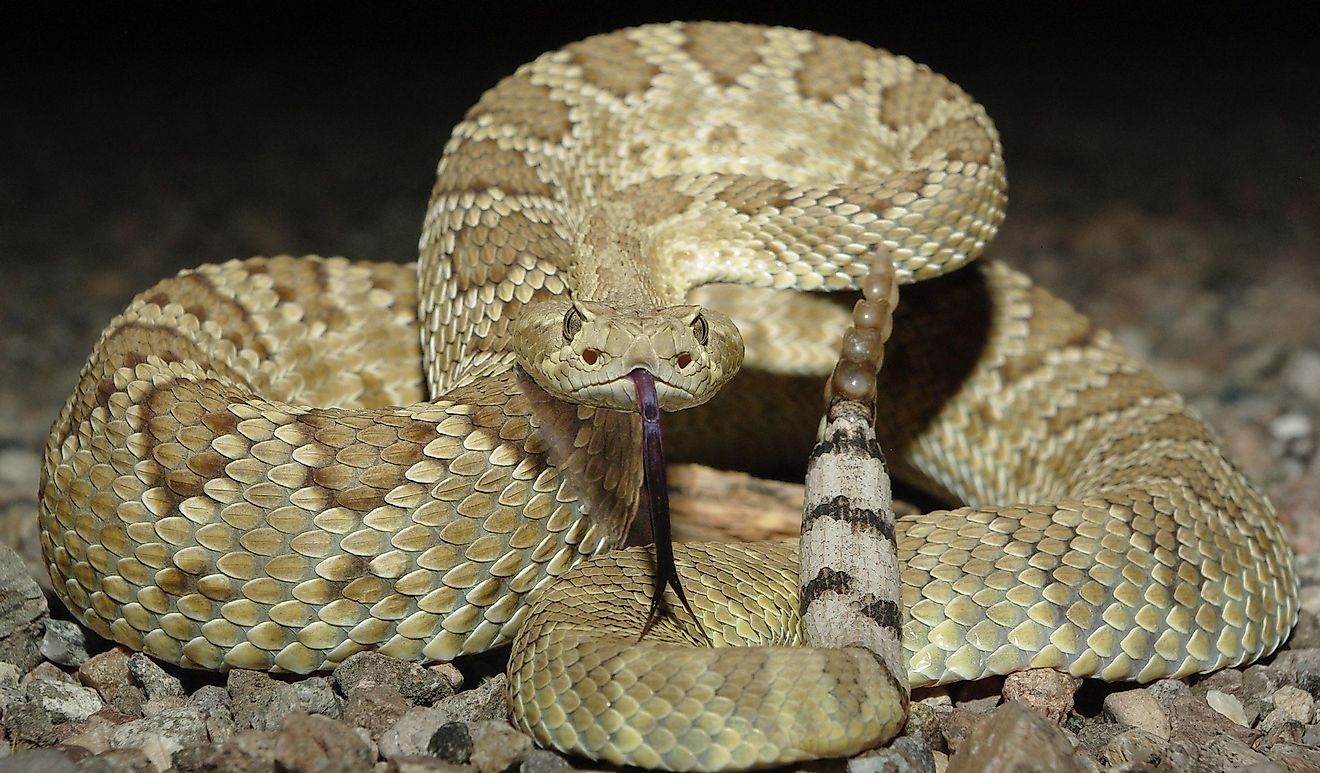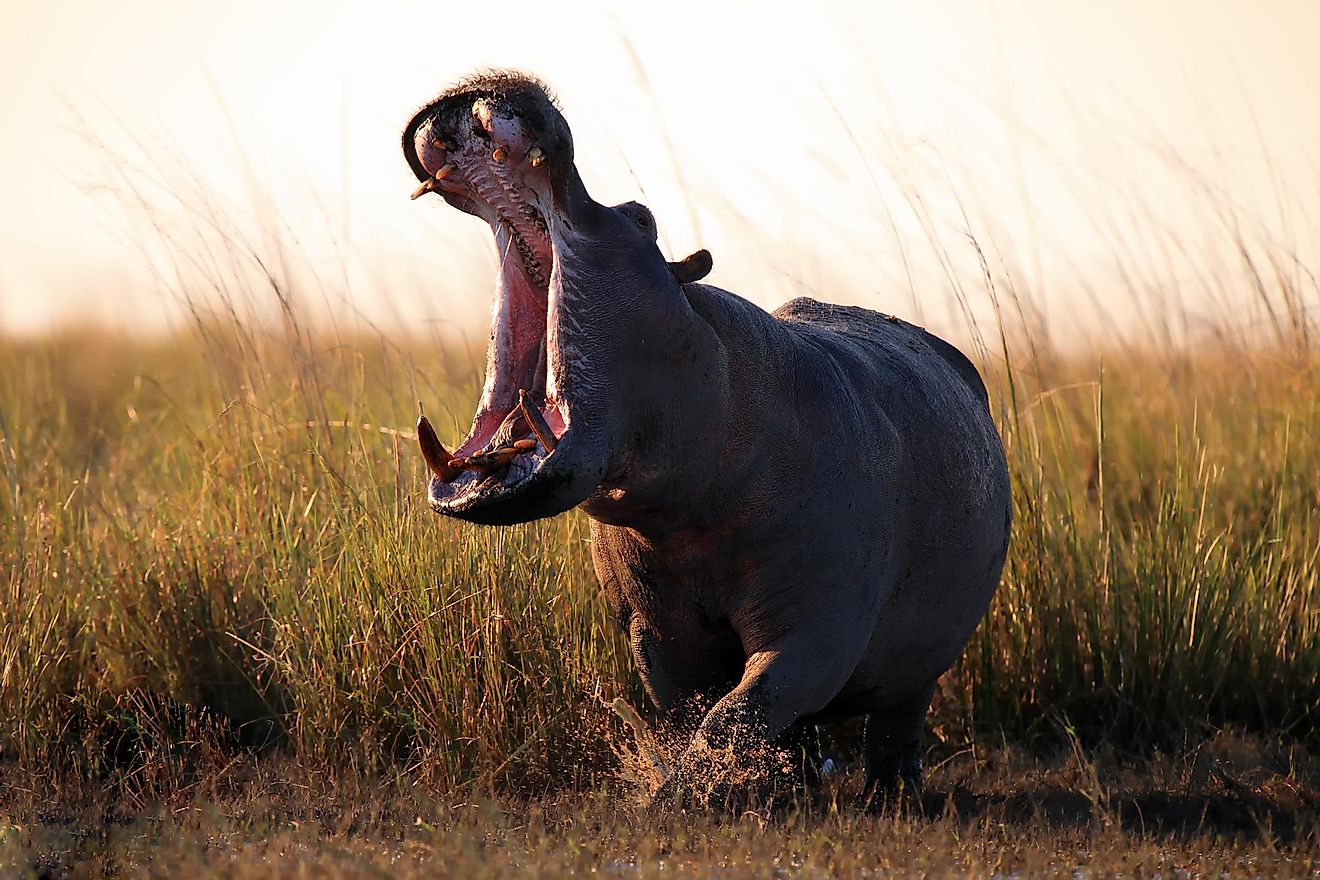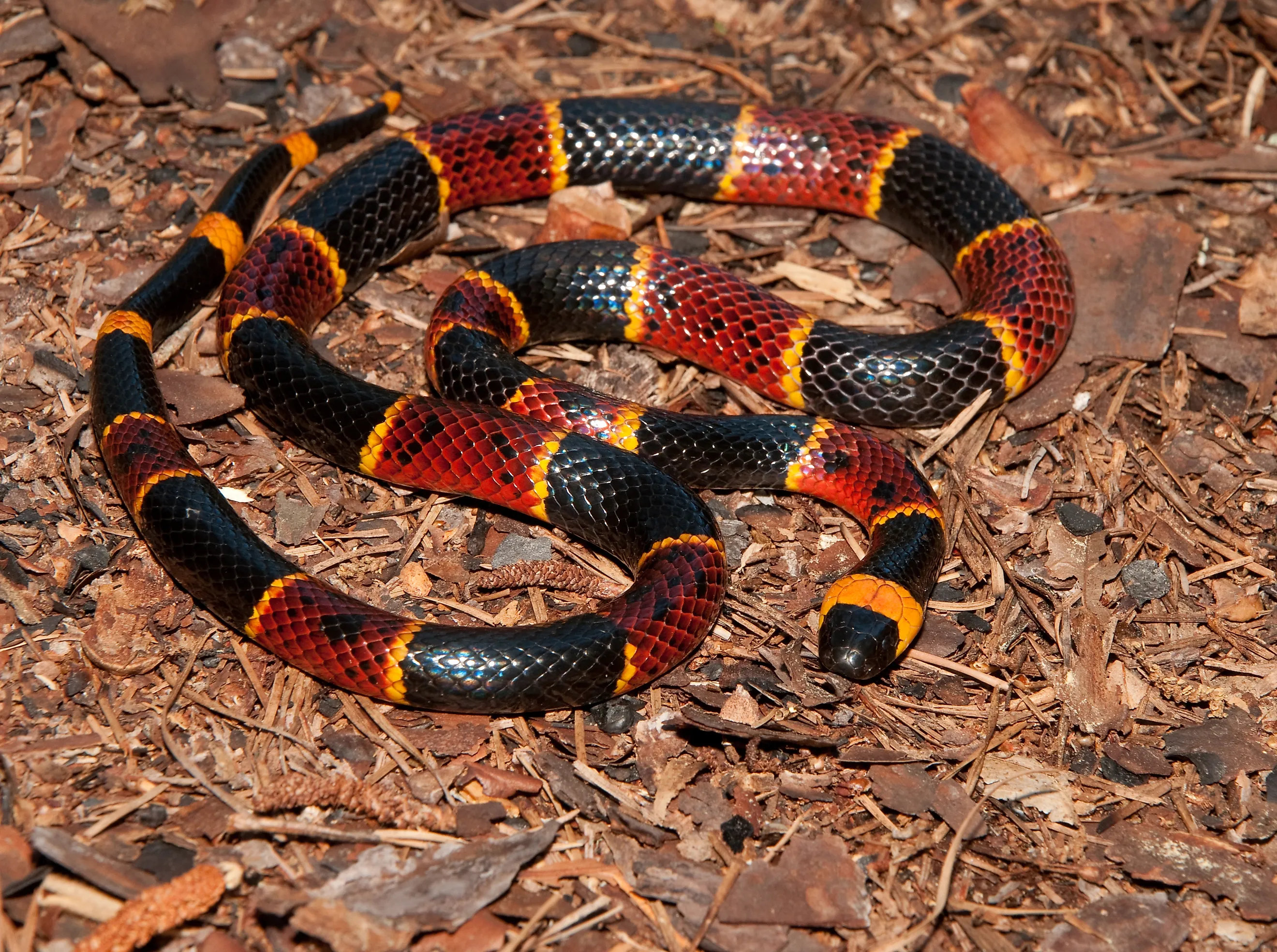
Snakes To Avoid In Texas
Texas is home to a wide variety of venomous snakes, each occupying the state's diverse habitats and posing unique risks to humans. From the deserts of the west to the forests and grasslands of the east, these snakes use camouflage, venom, and a slew of defensive behaviors to survive.
Understanding which species are present, their identifying features, habitats, and behavior is essential for your safety. Because of that, this quick guide highlights the species in Texas that are most important to recognize to help residents and visitors alike stay aware, avoid bites, and respect the state’s snake populations.
Western Diamondback Rattlesnake
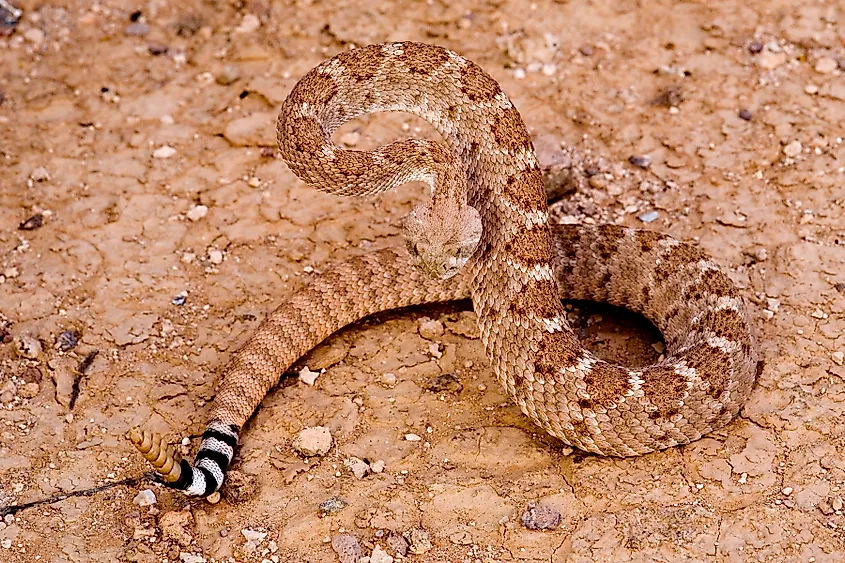
The western diamondback rattlesnake is often considered the most frequently encountered venomous snake in Texas. Found across deserts, grasslands, and scrublands (all abundant in northern and west Texas), it is identified by its distinctive diamond-shaped dorsal pattern and black-and-white banded tail.
Adult snakes typically measure between three and five feet long, though some exceed six feet. When threatened, the diamondback coils, raises its head, and rattles its tail as a warning, and its venom is primarily hemotoxic, damaging tissue and disrupting blood clotting. While fatalities are rare with prompt medical care, bites can cause severe pain and swelling.
Note that western diamondbacks are active mainly at dusk and night, especially in warmer months. They play an important ecological role by controlling rodent populations, and should always be observed from a safe distance.
Prairie Rattlesnake
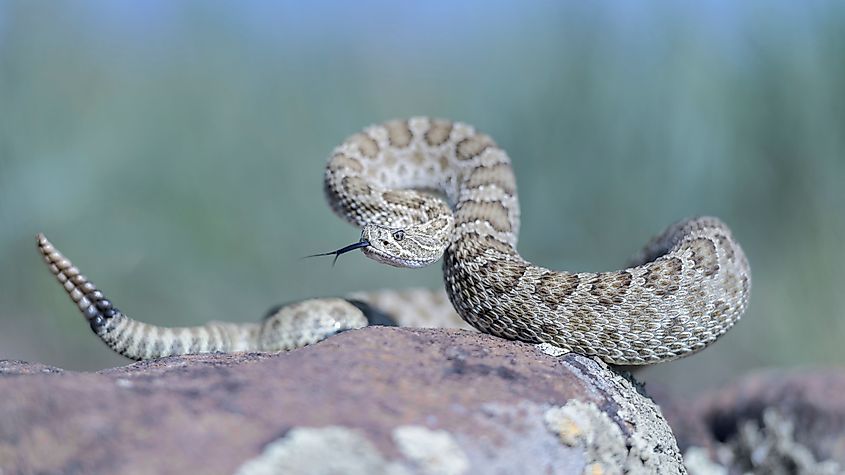
Prairie rattlesnakes are common across western and central Texas, especially in grasslands, rocky hillsides, and open prairies. They are easily recognized by their light brown or greenish bodies marked with darker oval blotches and a distinct rattle at the tail’s end. Adults usually range from three to four feet long.
Prairie rattlesnakes are primarily active in the evening and early morning, often hunting small mammals, birds, and lizards. During extreme heat, they tend to shelter in burrows, and although generally shy, they defend themselves when cornered. This snake’s venom is hemotoxic, affecting blood and tissue, and while rarely fatal with treatment, bites require immediate medical attention.
Overall, their presence helps regulate local prey populations, maintaining balance within the state’s grassland ecosystems, so avoiding them is good for both your safety and the health of the environment around them.
Mojave Rattlesnake
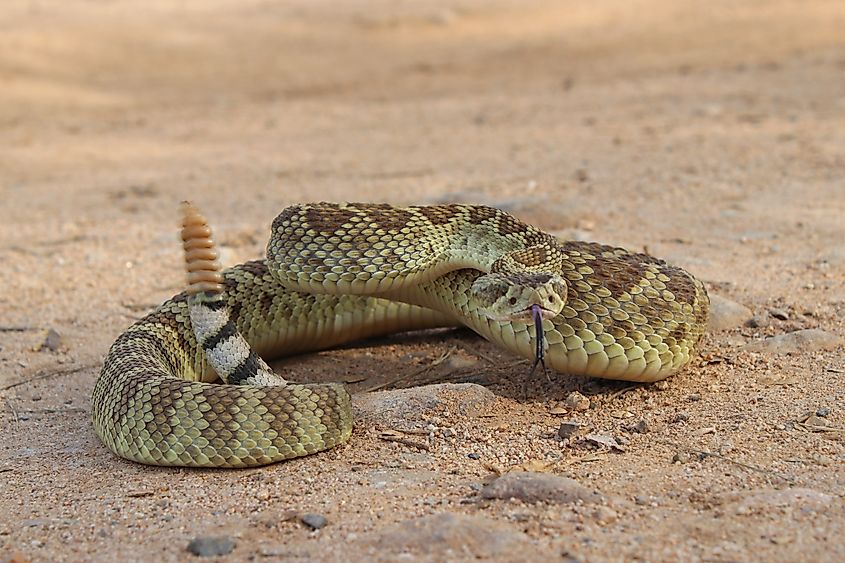
The Mojave rattlesnake inhabits the arid deserts and scrublands of western Texas, particularly near the Trans-Pecos region. This species is known for its potent venom, which contains both neurotoxic and hemotoxic components, making its bite one of the most dangerous among North American rattlesnakes. Symptoms can include muscle paralysis, vision problems, and respiratory distress, requiring urgent medical attention.
Adults typically measure between three and four feet long, and they are distinguished by their greenish or brown coloration, diamond-shaped back markings, and light tail bands near the rattle. Despite their reputation, they avoid human contact when possible, relying on camouflage and warning rattles before striking. Keep in mind that Mojave rattlesnakes are most active at night during warm months and hunt small mammals and lizards.
Black-tailed Rattlesnake
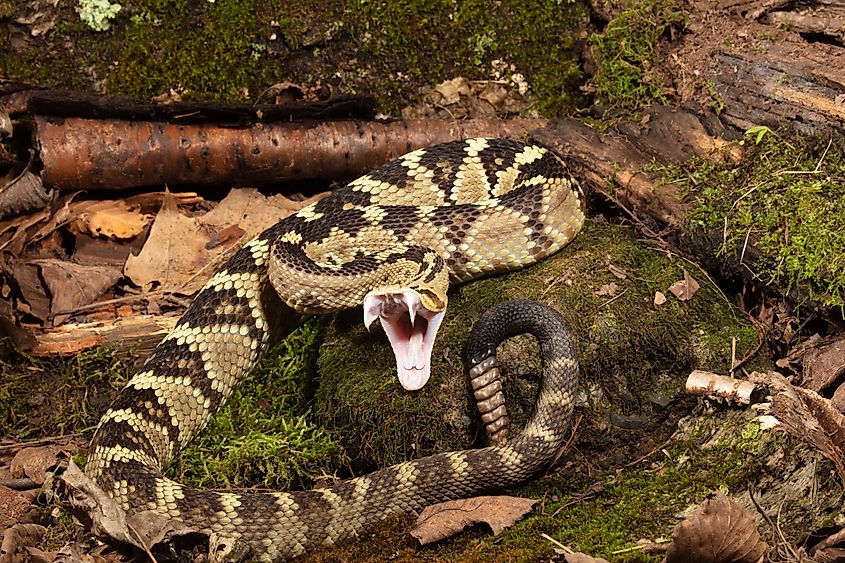
Black-tailed rattlesnakes are native to the rocky canyons, desert slopes, and oak woodlands of west and central Texas. They are pretty easily identifiable, with their yellowish or olive body covered in dark crossbands and a solid black tail preceding the rattle. They typically grow between three and four feet long, and the species has a relatively calm temperament compared to other rattlesnakes, but as usual, they will defend themselves if cornered.
Its venom is primarily hemotoxic, causing pain, swelling, and tissue damage, though bites are rarely fatal with proper care. With that, the black-tailed rattlesnake is a skilled ambush predator, feeding on rodents, birds, and small reptiles. It is mainly active from spring through early fall, favoring cooler evening and morning hours for hunting and movement.
Rock Rattlesnake
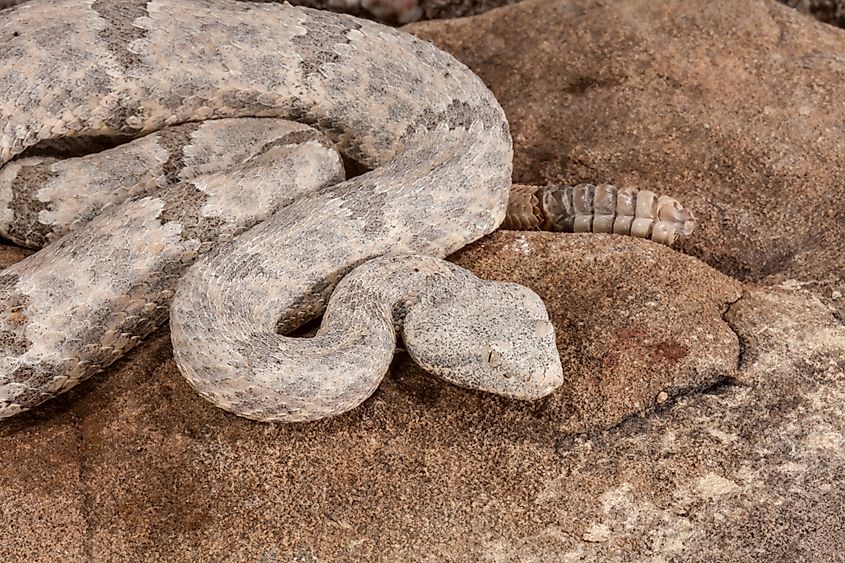
Rock rattlesnakes inhabit the more mountainous regions of west Texas, often at elevations above 4,000 feet! They favor rocky slopes, canyon ledges, and talus fields where their gray or greenish bodies blend almost perfectly with the surrounding stone. Adults are smaller than most other rattlesnake species, averaging around two feet long, and like a lot of other rattlers, their venom is primarily hemotoxic. Don't worry too much, their reclusive behavior makes all encounters uncommon.
These snakes spend much of the day hidden under rocks or within crevices, emerging in the evening to hunt small lizards and rodents. Interestingly, populations often vary in color depending on local geology; some appear pale gray, while others show bluish or olive hues, whichever helps them blend in better. Their camouflage is so effective, in fact, that even when nearby, they are rarely seen.
Timber Rattlesnake
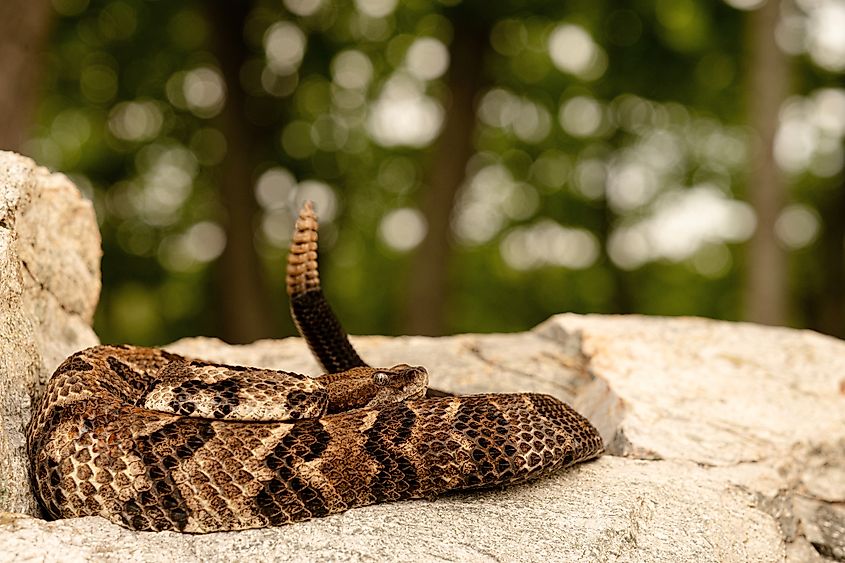
Timber rattlesnakes tend to occupy forested regions of east Texas, favoring wooded hillsides, limestone bluffs, and areas near streams. They are heavy-bodied snakes with dark crossbands over a background that ranges from yellowish-brown to gray, with adults sometimes exceeding four feet in length.
This variety of rattlesnake spends much of its time motionless, relying on camouflage to ambush small mammals and birds. Timber rattlesnakes are most active in late spring and early fall, opting to retreat to dens or hollow logs during colder months. Though their venom is potent, combining neurotoxic and hemotoxic effects, bites are rare due to their generally passive nature.
Keep in mind that timber rattlesnakes often vibrate their tails as a warning before striking. Also know that in Texas, they remain a protected species, their presence signaling a healthy, balanced woodland ecosystem.
Banded Rock Rattlesnake
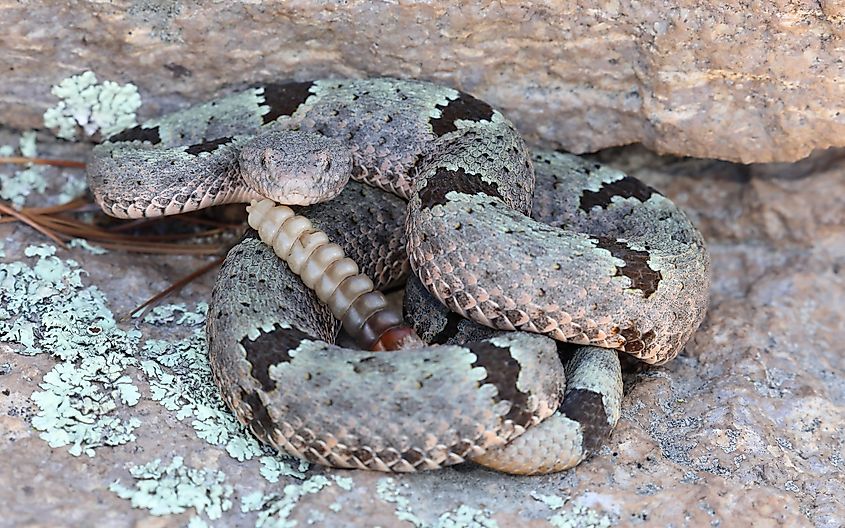
Banded rock rattlesnakes inhabit the rocky slopes and canyon ridges of west Texas. These small snakes, usually around two feet long, display pale gray or greenish bands that blend into limestone and granite surfaces. Their venom is primarily hemotoxic and less potent than that of larger rattlesnakes, though bites still require medical attention. They are effectively a subspecies of rock rattlesnake, and science is still determining the extent of their difference.
Like many desert-dwelling creatures, banded rock rattlesnakes spend much of the day hidden in crevices, emerging on warm nights to hunt primary food sources such as lizards and small rodents. They rely on camouflage rather than aggression to catch their meals, making human encounters uncommon unless cornered or stepped on.
Western Massasauga
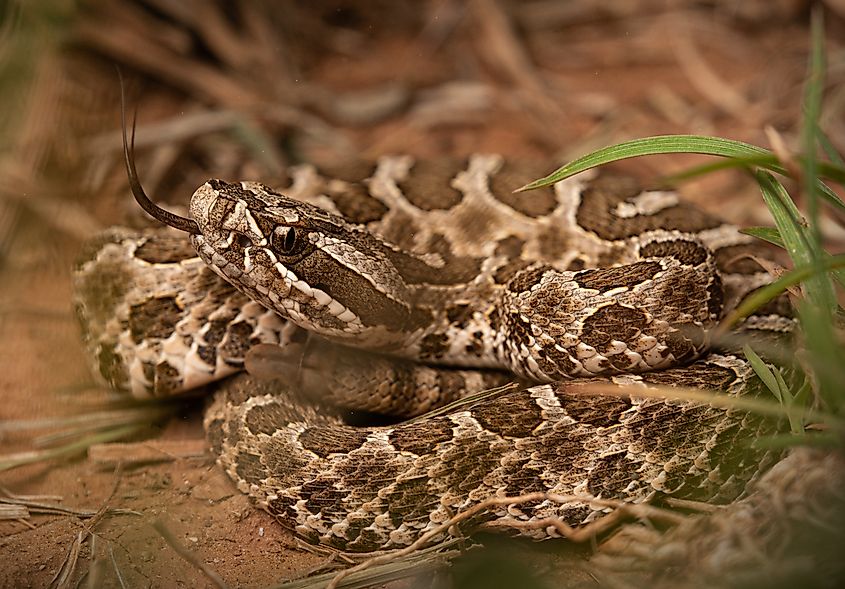
Western massasaugas stick to grasslands and prairies in north-central and western Texas. These small rattlesnakes rarely grow beyond two feet, with gray or light brown bodies patterned with dark blotches that provide effective camouflage in tall grasses and rocky terrain. Furthermore, habitat loss has reduced some populations, making western massasaugas an important species for various conservation efforts in Texas.
They are secretive snakes, typically active at dawn or dusk, and rely on cover to ambush small mammals, amphibians, and reptiles. Run-ins with people are uncommon in the sparsely populated areas they dwell in, yet caution is advised since their venom is hemotoxic.
Desert Massasauga
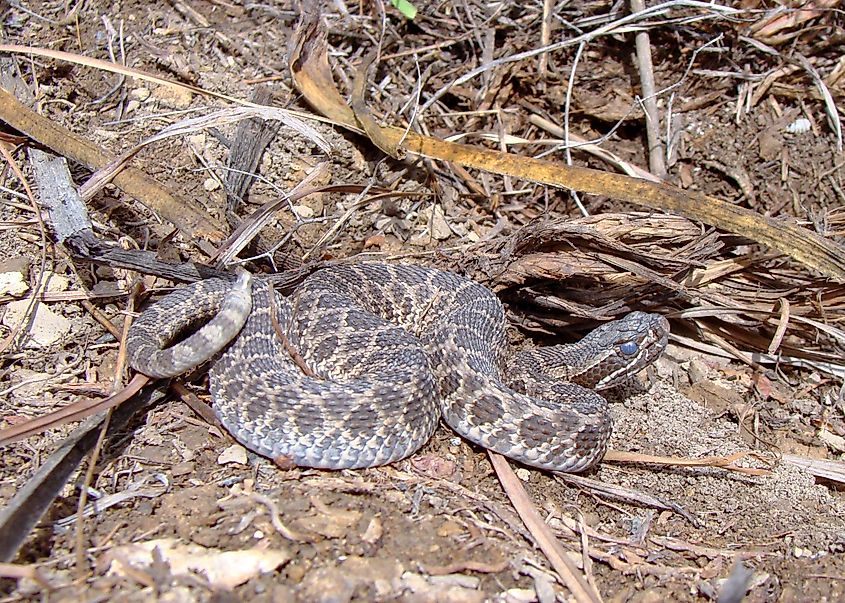
The desert massasauga is found in the arid grasslands and desert edges of West Texas. Like the western variety of these snakes, desert massasaugas are fairly small, not usually growing more than two feet in length, and have gray or tan bodies marked with dark blotches that allow them to blend into sandy and rocky terrain. Their venom is also primarily hemotoxic, causing localized pain and swelling, though bites are rarely fatal with medical care.
Encounters with humans are uncommon due to their reclusive behavior. Habitat degradation and fragmentation have even impacted populations in some areas, making desert massasaugas a species of concern. Regardless, they continue to play an important role in regulating prey populations in their native ecosystems.
Pygmy Rattlesnake
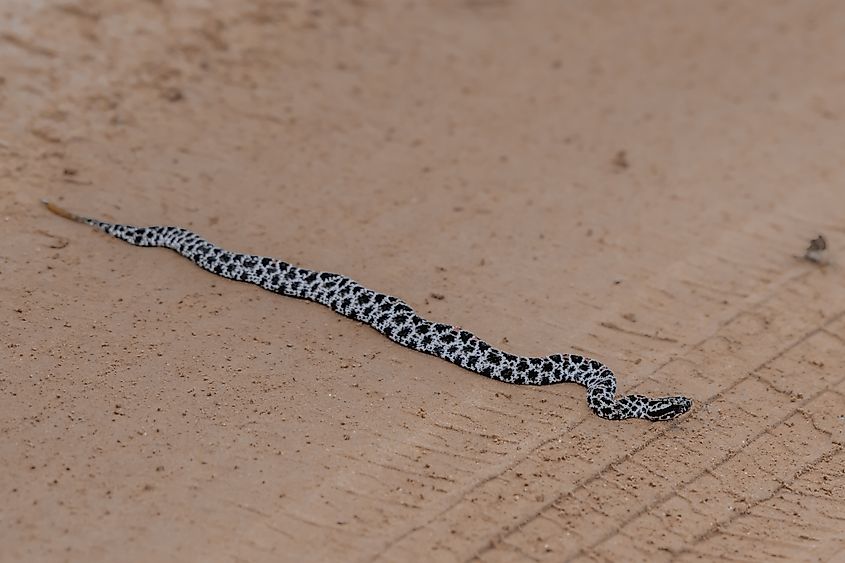
Pygmy rattlesnakes are, as you may have imagined, small, stout-bodied snakes found in parts of eastern and central Texas, often in pine forests, wetlands, and grassy fields. Even though they are small in size, pygmy rattlesnakes still play a vital role in controlling local prey populations. Full-grown adults typically measure only 12 to 24 inches long and display a series of dark dorsal blotches on gray, brown, or reddish backgrounds.
Pygmy rattlesnakes tend to be quite secretive and rely heavily on camouflage, spending much of the day hidden under leaves or debris. Activity peaks in warmer months, with these snakes moving mostly during the day or early evening, depending on temperature. They hunt small frogs, lizards, and rodents using ambush tactics.
Copperheads
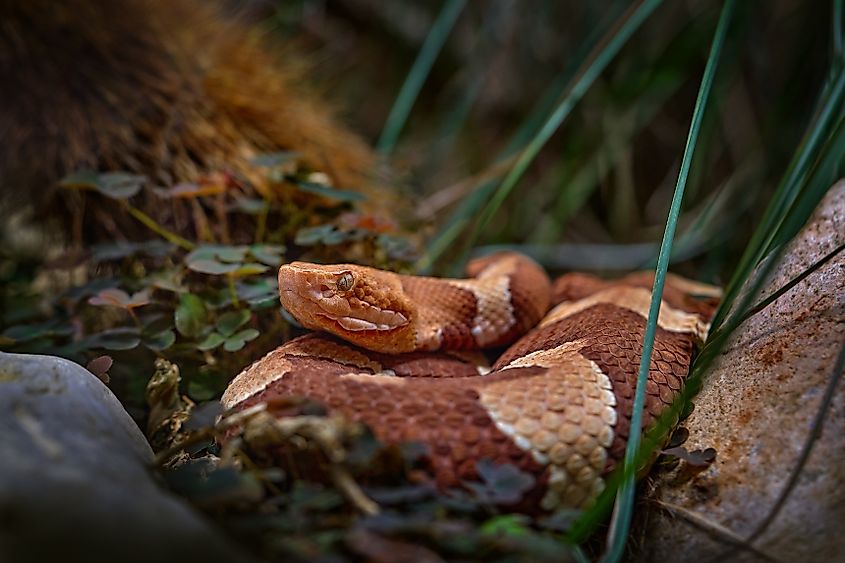
Copperheads occur across eastern and central Texas in the region's various mixed woodlands, rocky streambanks, and brushy edges near water. Grown Copperheads average two to three feet, with a copper-colored head and darker hourglass-shaped bands along a tan to gray body.
They hunt by ambush, feeding on rodents, frogs, and large insects, often concealed in leaf litter or near logs, and are most energetic in spring and fall when the extreme summer heat of Texas abates.
Because their camouflage and tendency to freeze when approached increase accidental contact, maintain awareness on trails and seek immediate medical care for any suspected bite. Their bites produce severe pain, swelling, and local tissue damage, but deaths are thankfully rare with prompt medical care.
Texas Coral Snake
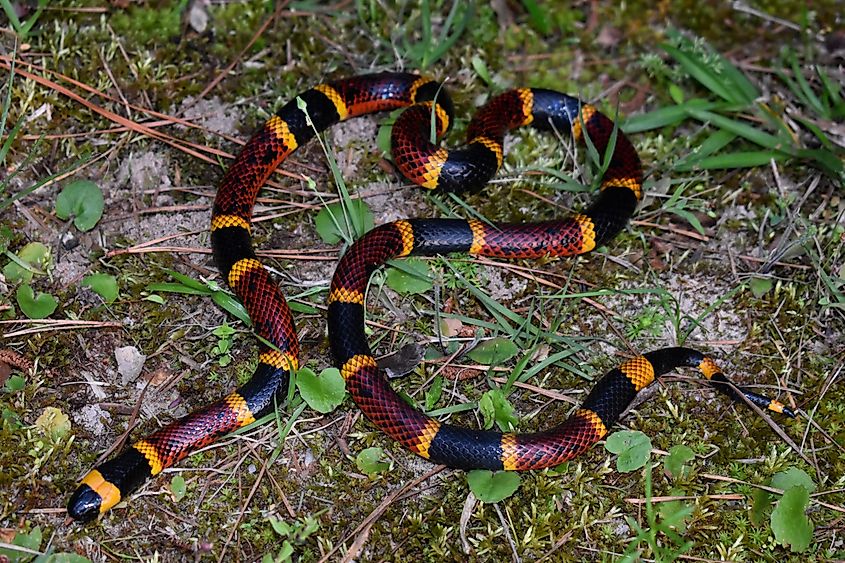
Texas coral snakes are found along the state's length of Gulf coastline, favoring nearby pine forests, sandy soils, and brushy areas. They have relatively short fangs and are smaller and more slender than many other species, typically 20 to 30 inches long, with distinctive red, yellow, and black banding that signals their venomous nature.
While generally avoiding humans, any bite requires immediate medical attention. Their venom is neurotoxic, affecting the nervous system and potentially causing respiratory paralysis, though fatal bites are extremely rare due to their reclusive behavior.
Texas coral snakes are primarily nocturnal and spend much of their time underground, under logs, or in leaf litter. They actually feed on smaller snakes, lizards, and amphibians, using stealth and quick strikes to overcome their prey.
Cottonmouths
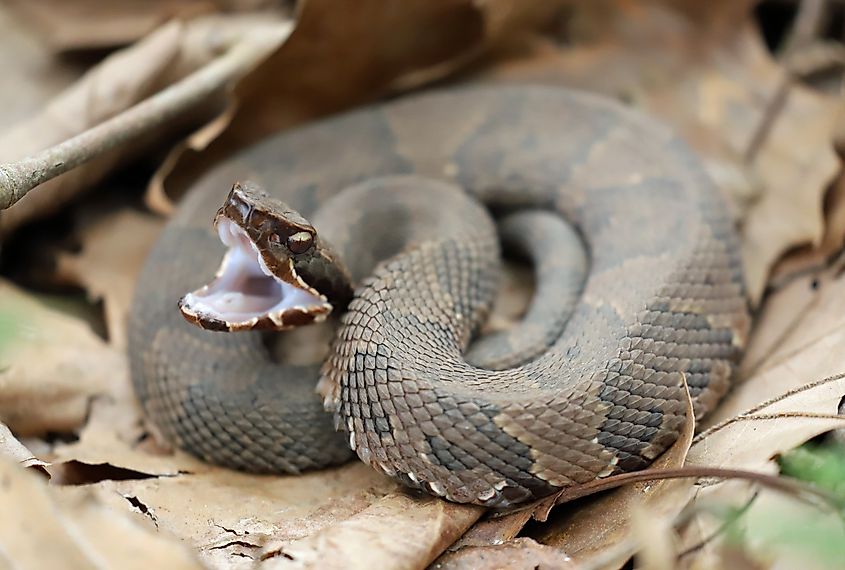
Cottonmouths, also known as water moccasins, inhabit many of the swamps, marshes, ponds, and slow-moving streams across East Texas. These semi-aquatic snakes are fairly common across the country, and have relatively girthy bodies that can reach lengths of three to four feet. Their coloration varies from dark olive to nearly black, often with faint crossbands.
Cottonmouths are both predators and scavengers, feeding on fish, frogs, and small mammals. When threatened, cottonmouths display a defensive gape, revealing the white interior of their mouths, and can administer hemotoxic venom with their bites. They do most of their daily activities at night, especially during warm, humid weather, meaning you should bring a flashlight if you intend to walk in their territory after the sun goes down. Also note that because they can remain motionless for long periods near the water’s edge, they are often mistaken for less aggressive, nonvenomous water snakes, so caution is advised around aquatic habitats.
Better Understand Texas's Potentially Dangerous Snakes
The Lone Star State clearly hosts a wide range of venomous snakes within its massive borders. Awareness of their appearance, behavior, and habitats is crucial for preventing bites and ensuring your safety, whether hiking along the Rio Grande or lounging on a Gulf Coast beach.
While encounters are, for the most part, rare, respecting these snakes and maintaining distance protects both them and you. Moreover, by understanding their role in the state's highly diverse ecosystems, from controlling rodent populations to maintaining general ecological balance, Texans can coexist safely with these reptiles while appreciating their environmental importance at the same time.
